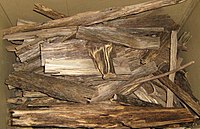
Photo from wikipedia
AbstractAgarwood is a non-timber forest product found in tropical rain forests. It is a black and fragrant resin valued for the perfume industry and demand continues to increase. However, the… Click to show full abstract
AbstractAgarwood is a non-timber forest product found in tropical rain forests. It is a black and fragrant resin valued for the perfume industry and demand continues to increase. However, the Indonesian agarwood-producing species, Aquilaria malaccensis and Gyrinops versteegii do not automatically produce such quality resin. Bio-induction technology or inoculation using Fusarium solani is usually applied to these species to trigger resin production. This research aims to identify agarwood compounds formed in seedlings and trees of A. malaccensis and G. versteegii after these species were inoculated with the fungus F. solani. The chemical compounds were identified by comparing the patterns of mass spectra fragmentation in the sample and in previous studies. Five groups of agarwood compounds were identified: (1) sesquiterpen group—cis-jasmone and aromadendrenepoxide; (2) chromones group—8-methoxy-2-(2-phenylethyl)chromen-4-one and newly-discovered chromone derivative, 7-(benzyloxy)-5-hydroxy-2-methylchromone found only in G. versteegii; (3) aromatic group—benzylacetone, guaiacol, p-ethylguaiacol, phenol, syringaldehyde, vanilin, furfuryl alcohol, and furfural; (4) fatty acid group—palmitic acid, oleic acid, and lauric acid; and, (5) triterpen group—squalene.
Journal Title: Journal of Forestry Research
Year Published: 2019
Link to full text (if available)
Share on Social Media: Sign Up to like & get
recommendations!